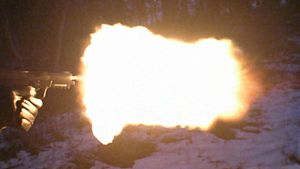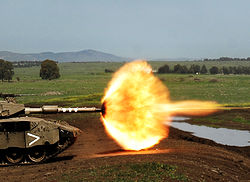31:
20:
308:, and interfere with the hydrogen-oxygen combustion to reduce the muzzle flash. The side effects of the alkali salts are a reduction in power, an increase in smoke, and fouling and corrosion of the firearm and nearby equipment (a significant concern with aircraft guns).
132:
422:
267:
attempt to suppress the flash mechanically, by interfering with the blast wave using either a cone or a series of slots at the muzzle of the firearm. However, since the primary cause of the secondary flash is combustion of
390:
253:, muzzle flash can temporarily blind the shooter, or give away the shooter's location, especially at night. Ingestion of the muzzle flash from aircraft-mounted guns has also been implicated in
330:, which slows the gases and dissipating their energy over a larger surface area before releasing them at a cooler temperature. The enclosure of the silencer can also serve as a
170:. Although amongst the brightest of the flashes, the heat of the primary flash dissipates very quickly, and thus is usually not distinctly noticeable.
166:
is caused by superheated propellant gases exiting the firearm behind the projectile, which radiates its energy to the surroundings partly as
326:, can also suppress muzzle flash. This is done by trapping and delaying the expansion of the propellant gases with containing multiple
284:(table salt) were placed in front of the propellant charges of artillery to suppress the flash. Addition of a few percent of
453:
181:
created by the high speeds of the escaping gases and projectile, and appears as a reddish disc-shape in front of the muzzle.
241:
imaging technology. Technology is being developed to detect enemy muzzle flashes before the projectile reaches its target.
159:. It glow is created by superheated gases that have leaked past the projectile and have exited the barrel ahead of it.
249:
Muzzle flash, particularly the longer-duration secondary flash, is an inherent problem in most firearms. Due to its
207:
Following the dissipation of the muzzle flash, partially unburnt powder or other heated materials (e.g. dislodged
492:
417:
497:
445:
301:
437:
471:
8:
319:
297:
67:, which is caused by the sudden release and expansion of high-temperature, high-pressure
289:
100:
449:
438:
309:
293:
288:
to the powder for flash suppression is common, typically salts of potassium such as
313:
254:
72:
56:
420:, Winkler, David Allen, "Gun Flash Suppressants", published 1986-09-24
377:
281:
273:
402:
502:
42:
486:
358:
331:
167:
120:
23:
343:
327:
224:
64:
348:
285:
277:
264:
222:) can be further ejected from the muzzle and appear as airborne residual
112:
353:
250:
178:
156:
116:
104:
88:
84:
30:
193:
92:
334:
to physically conceal any light emitted by the gases and residuals.
237:
Muzzle flashes create distinct signatures that can be located using
305:
269:
258:
238:
136:
80:
60:
477:
323:
219:
76:
38:
216:
212:
201:
197:
152:
143:
Muzzle flash can be broken down into five distinct components.
108:
35:
139:. Note the minor flash at the gap between cylinder and barrel.
99:. The size and shape of the muzzle flash is dependent on the
189:
111:
remaining, and any devices attached to the muzzle (such as a
52:
188:
appears farthest from the muzzle as a large white or yellow
95:), and any remaining unburned powders reacting with ambient
19:
208:
131:
96:
68:
436:
Meyer, Rudolf; Köhler, Josef; Homburg, Axel (2007).
416:
435:
484:
83:. Both the blast and flash are products of the
322:, while designed to mitigate the loud sound of
478:Tutorial on how to add muzzle flares to a gun
151:is a reddish glow that is visible before the
412:
410:
316:salts have also been tried with success.
276:, chemical approaches are also used. In
130:
29:
18:
485:
407:
107:being used, the amount of combustible
403:Infrared sniper detection enhancement
304:. In both cases, the salts act as
192:, and is caused by a newly ignited
13:
126:
14:
514:
465:
429:
396:
383:
370:
244:
204:in the surrounding atmosphere.
1:
418:WO application 1986001796
364:
261:, causing loss of aircraft.
232:
7:
337:
10:
519:
391:Gun Muzzle Blast and Flash
196:of incompletely combusted
200:when mixed with abundant
474:of shotgun muzzle blasts
16:Light created by gunfire
472:High-speed photographs
140:
45:
27:
444:. Wiley-VCH. p.
302:potassium bicarbonate
134:
33:
22:
493:Firearm terminology
298:potassium carbonate
34:Muzzle flash of an
440:Explosives, 6th Ed
290:potassium chloride
175:intermediate flash
141:
135:Muzzle flash of a
87:combustion of the
46:
28:
455:978-3-527-31656-4
310:Ammonium chloride
294:potassium sulfate
101:combustion energy
510:
460:
459:
443:
433:
427:
426:
425:
421:
414:
405:
400:
394:
389:G. Klingenberg,
387:
381:
380:, 14 August 2006
376:Tony DiGiulian,
374:
314:ammonium nitrate
255:compressor stall
518:
517:
513:
512:
511:
509:
508:
507:
483:
482:
468:
463:
456:
434:
430:
423:
415:
408:
401:
397:
388:
384:
375:
371:
367:
340:
282:sodium chloride
274:carbon monoxide
247:
235:
186:secondary flash
129:
127:Characteristics
63:— created by a
17:
12:
11:
5:
516:
506:
505:
500:
495:
481:
480:
475:
467:
466:External links
464:
462:
461:
454:
428:
406:
395:
393:, 21 July 1988
382:
368:
366:
363:
362:
361:
356:
351:
346:
339:
336:
246:
243:
234:
231:
230:
229:
205:
182:
171:
160:
128:
125:
43:IMI 120 mm gun
41:IIId Baz tank
15:
9:
6:
4:
3:
2:
515:
504:
501:
499:
498:Light sources
496:
494:
491:
490:
488:
479:
476:
473:
470:
469:
457:
451:
447:
442:
441:
432:
419:
413:
411:
404:
399:
392:
386:
379:
373:
369:
360:
359:Muzzle shroud
357:
355:
352:
350:
347:
345:
342:
341:
335:
333:
332:muzzle shroud
329:
328:sound baffles
325:
321:
317:
315:
311:
307:
303:
299:
295:
291:
287:
283:
279:
275:
271:
266:
262:
260:
256:
252:
242:
240:
227:
226:
221:
218:
214:
210:
206:
203:
199:
195:
191:
187:
183:
180:
177:is caused by
176:
172:
169:
168:visible light
165:
164:primary flash
161:
158:
154:
150:
146:
145:
144:
138:
133:
124:
122:
121:muzzle shroud
118:
114:
110:
106:
102:
98:
94:
90:
86:
82:
78:
74:
70:
66:
62:
58:
54:
50:
44:
40:
37:
32:
25:
24:FN Five-seven
21:
439:
431:
398:
385:
378:Muzzle flash
372:
344:Muzzle blast
318:
286:alkali salts
265:Flash hiders
263:
248:
236:
223:
185:
174:
163:
148:
142:
65:muzzle blast
49:Muzzle flash
48:
47:
26:muzzle flash
349:Flash hider
278:World War I
245:Suppression
179:shock waves
155:leaves the
149:muzzle glow
113:flash hider
487:Categories
365:References
354:Suppressor
280:, bags of
251:brightness
117:suppressor
105:propellant
89:propellant
85:exothermic
320:Silencers
306:catalysts
233:Detection
194:oxidation
93:gunpowder
71:from the
338:See also
270:hydrogen
259:flameout
239:infrared
220:foulings
190:fireball
137:revolver
81:shooting
61:infrared
324:gunfire
215:and/or
79:during
77:firearm
57:visible
55:— both
51:is the
39:Merkava
36:Israeli
452:
424:
225:sparks
217:carbon
213:copper
202:oxygen
198:ejecta
157:barrel
153:bullet
109:ejecta
73:muzzle
503:Noise
75:of a
69:gases
53:light
450:ISBN
312:and
300:and
272:and
257:and
209:lead
184:The
173:The
162:The
147:The
59:and
446:218
123:).
119:or
103:of
97:air
489::
448:.
409:^
296:,
292:,
211:,
115:,
458:.
228:.
91:(
Text is available under the Creative Commons Attribution-ShareAlike License. Additional terms may apply.


